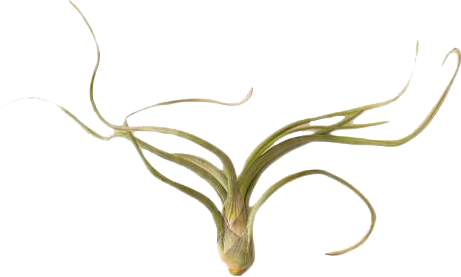 Image 1 of 1
Image 1 of 1


Tillandsia Arauji - Air Plant
Botanical Name: Tillandsia Araujei
Description: Tillandsia araujei is caulescent (growing along a stem) and has thick succulent leaves that tend to point towards the light. They have rose colored inflorescence that produce white flowers. They quickly form large symmetrical clumps that are spectacular. Air plants differ greatly from other plants in how they absorb water, as they do not need a root system. Their roots are mainly used to secure them to other plants or rocks for anchoring. Instead, along the leaves of tillandsias are tiny hair-like structures called trichomes. This is how they take in moisture. In air plants that live in dry arid climates, the number of trichomes will be ample, giving the plant that famous silver or white look they are so well-known for. Tillandsia Medusae is a great large Air Plant species, easy to cultivate and very versatile.
NATIVE LAND: Brazilian Coast
WATER: Light mistings every 2-3 days. If 2-3 days is a bit excessive to remember, leave out a bowl of tap water overnight (allowing the chlorine and fluoride to evaporate), and place the plants inside the water for a couple hours. Take out and shake excess water out. Place plant as much on its “face” as possible, making sure not to allow water to sit inside the plant. Repeat every 3-4 weeks. An easy and Ideal location for many air plants is a bathroom for the constant natural humidity.
LIGHT: Bright, indirect light. Direct sunlight may cause your plant to dry out
ISSUES:
leaf tips turning brown/crispy -underwatering
plant seems to be falling apart -overwatering
BENEFITS: Air purification and very unique style opportunities, as there is no need for roots or dirt. The home design opportunities are endless.
PET/KID FRIENDLY: Not toxic to humans or pets
Botanical Name: Tillandsia Araujei
Description: Tillandsia araujei is caulescent (growing along a stem) and has thick succulent leaves that tend to point towards the light. They have rose colored inflorescence that produce white flowers. They quickly form large symmetrical clumps that are spectacular. Air plants differ greatly from other plants in how they absorb water, as they do not need a root system. Their roots are mainly used to secure them to other plants or rocks for anchoring. Instead, along the leaves of tillandsias are tiny hair-like structures called trichomes. This is how they take in moisture. In air plants that live in dry arid climates, the number of trichomes will be ample, giving the plant that famous silver or white look they are so well-known for. Tillandsia Medusae is a great large Air Plant species, easy to cultivate and very versatile.
NATIVE LAND: Brazilian Coast
WATER: Light mistings every 2-3 days. If 2-3 days is a bit excessive to remember, leave out a bowl of tap water overnight (allowing the chlorine and fluoride to evaporate), and place the plants inside the water for a couple hours. Take out and shake excess water out. Place plant as much on its “face” as possible, making sure not to allow water to sit inside the plant. Repeat every 3-4 weeks. An easy and Ideal location for many air plants is a bathroom for the constant natural humidity.
LIGHT: Bright, indirect light. Direct sunlight may cause your plant to dry out
ISSUES:
leaf tips turning brown/crispy -underwatering
plant seems to be falling apart -overwatering
BENEFITS: Air purification and very unique style opportunities, as there is no need for roots or dirt. The home design opportunities are endless.
PET/KID FRIENDLY: Not toxic to humans or pets











